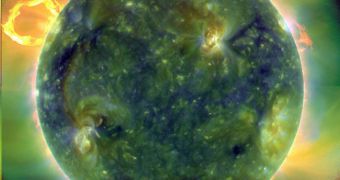Officials at the American space agency said recently that their newly-launched Solar Dynamics Observatory (SDO) was one of the most remarkable pieces of equipment ever deployed to study the Sun. Speaking at the 216th meeting of the American Astronomical Society (AAS 2010), held in Miami, Florida, experts with the mission explained that we are currently getting a new understanding of how the star works at various wavelengths, and that it's all due to this instrument. The SDO was launched on February 11, 2010, and has only recently finished undergoing its testing and commissioning phases.
According to speakers at the conference, information collected by the SDO has thus far been able to provide more clues into how small-scale events, taking place on or below the surface of our star, are capable of influencing our planet to a great degree. Some solar phenomena, for instance, can easily disrupt communications on Earth, destroy power grids, fry satellites in orbit, and endanger the lives of astronauts on the International Space Station (ISS). The Sun's inner workings are already beginning to be revealed, thanks to the instruments that make up SDO's arsenal.
“The Sun is a major part of our everyday lives. The biggest thing about SDO is that it's enabling the prediction of space weather,” explained SDO project scientist Dean Pesnell, who is based at the NASA Goddard Space Flight Center, in Greenbelt, Maryland. “Even small events restructure large regions of the solar surface. It's been possible to recognize the size of these regions because of the combination of spatial, temporal and area coverage provided by [the Atmospheric Imaging Assembly instrument,” adds the SDO AIA principal investigator, Alan Title. He works at the Palo Alto, California-based Lockheed Martin Advanced Technology Center.
“Although we knew that these small-scale emergences affected regions locally – at maybe five or 10 times their diameter – we had not known that there was the potential for much larger-scale restructuring to occur,” Title added. “Until we understand how these connections work and how fast they are, we won't really understand what really kicks off solar flares and coronal mass ejections, For the first time, we'll be able to see these connections and understand the physics that is involved with this restructuring and the energy that is involved,” he concluded. AIA is currently snapping about 70,000 images each day, Space reports.

 14 DAY TRIAL //
14 DAY TRIAL //